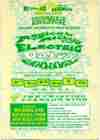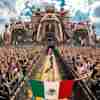Electric Daisy Legacy: Meet the Man Behind the First EDC


courtesy of Jeanie Chang
In just less than a week, the Las Vegas Motor Speedway will be transformed. Fireworks will fill the sky, multicolored lights and lasers will be visible across the Las Vegas Valley, and the sound of thumping bass will reverberate far and wide.
It’s inarguable that in today’s music world, Electric Daisy Carnival — the three-day event that takes over the speedway each year — has become synonymous with dance music and rave culture in the United States. Even if you’re not part of the scene, it’s likely you know about EDC. For many of today’s ravers, EDC is the mecca — a dream festival on par with the United Kingdom’s Creamfields and Belgium’s Tomorrowland. The event is a massive sea of faces, costumes, and carnival rides. During the last iteration in 2019, EDC drew in approximately 450,000 attendees. But this level of spectacle didn’t just happen overnight.


Insomniac Events
The first EDC, held in 1991, was borne of an underground subculture that was just beginning to see the light of day. Originally called Magical Mickey’s Electric Daisy Carnival, the event was conceived of, created, and organized by Stephen Hauptführ and Gary Richards (aka Destructo), with help from a group of close-knit friends. Hauptführ was introduced to acid house as an art student in London and — upon his return to the United States — had developed a passion for the genre and wanted to share it.
“We had friends who put on events, but they wouldn’t hire us because they said no one wanted to hear this music.’” Hauptführ remembers.
The group didn’t let the initial rejection deter them, though. They started throwing events with — as Hauptführ recalls with a laugh — “all sorts of crazy themes.” Inspired by his childhood love for fantastical worlds à la “Alice in Wonderland,” Hauptführ procured circus tents for shelter, created flyers with 70’s-inspired bubble letters, and secured venues like water parks, warehouses, and — in the first EDC’s case — wide, empty fields to create the events of his dreams. His whimsy is still very much infused in the EDC of today.


EDC 1991 drew in somewhere between 3,000 to 3,500 people, according to Hauptführ. He worked with his team to transform a dairy-farm-surrounded field in Chino, California into an outdoor carnival, complete with rides, lights, music, and decorations.
To prepare for the events they threw, the group gathered in the downtown LA loft that Hauptführ shared with several friends. “We’d get together a few weeks before to make all of the displays and decorations,” says Ken Starks, who was Hauptführ’s roommate, in addition to helping to throw EDC 1991. “We used a lot of found objects, DayGlo, and foam. We had a blast doing that stuff.”
Many of the attendees of the 1991 event had already attended Hautführ’s underground parties since he began throwing them in 1986. And for them, the first EDC was unlike anything they had ever seen before.
“When Steve threw the first one, it was groundbreaking,” says Jeanie Chang, who was a regular at Hauptführ’s events and sometimes helped organize them. “It blew everyone’s minds, and everyone had a great time. It was revered as one of the coolest events that happened back then.”
And for Hauptführ, it was a moment to celebrate, too. EDC marked a shift from the secretive, underground raves — that would sometimes be discovered and shut down by authorities — to a different future, where such events were possible without the veil of secrecy.
“Everyone coming together was amazing,” says Hauptführ. “It was this weird world that didn’t exist before, especially in that time period.”


Hauptführ remained at the helm for the 1992 event — which took place near El Mirage Dry Lake in California’s Mojave Desert — and also threw EDC in 1995, before licensing the name to Pasquale Rotella, CEO of Insomniac Events. Rotella was a former street team promoter for Hauptführ’s raves. In 1997 He took EDC to the Shrine Expo Hall in Los Angeles for the first Insomniac-branded iteration. After an EDC-less 1998, Rotella put on the event again the next year, this time at the now-defunct Lake Dolores Waterpark in Newberry Springs, California.
The event jumped between California venues from 2000-2010 — most notably the NOS Events Center in San Bernardino and the Los Angeles Memorial Coliseum — before finding a permanent home in Las Vegas in 2011.
Now, the event has iterations across the globe, from Mexico to South Korea. This year’s EDC will have eight stages and numerous DJ-toting art cars, in addition to after-hours parties at the affiliated campground, larger-than-life art installations, and — of course — the much-lauded nightly EDC fireworks show.
In 2021, EDC is larger than life. And so — it seems — is the dance music scene. The genre reached an unprecedented peak in the 2010s, and though the market appears to have cooled off in recent years, the appeal of dance music is still wide-reaching. In many ways, the growth of massive festivals like EDC have escorted the associated music into the mainstream.
When Hauptführ threw the first EDC, the most common way to find the location of a rave was through getting map points: location coordinates that would be provided to attendees after tickets had been purchased. Events had to be secretive, both for exclusivity and for fear that authorities might shut down the parties. But even with the anti-drug legislation that resulted in a crackdown on raving, the dance music community was a growing force. The widespread adoption of technology and excitement for new sounds resulted in what is now referred to as the “EDM boom” of the 2010s.


Pop and hip-hop superstars like Sia and Nicki Minaj joined forces with producers like David Guetta to create some of the era's genre-defining dance-pop anthems, and artists like Skrillex and Zedd made waves with their new sounds and lyric-free choruses. As dance music was coming up, so was EDC.
“You can definitely see parallels. The events go along with the music becoming more mainstream and more widely understood and recognized,” Hauptführ says. “If you lay down the two timelines together, they will be pretty parallel.”
When Hauptführ first heard dance music, he knew it was special. And likewise, everyone at the first EDC knew they were witnessing history. Although the scene — and the events that go with it — have grown exponentially since that first gathering in the fields outside Chino, the otherworldly playfulness Hauptführ and his team brought to the first attendees can still be felt by the hundreds of thousands of ravers that still gather together each year.
